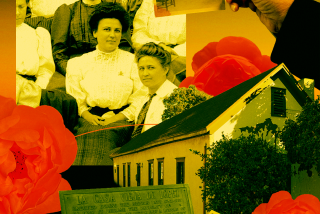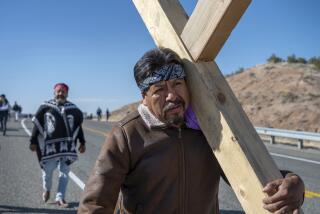LANDMARKS / COUNTY HISTORICAL SITES : Last Resting Place of a Founding Family
- Share via
HISTORY: The cornerstone of St. Mary Magdalen Church was laid on July 1, 1913. In 1940, the church was donated to the community, and in 1972, it was designated as a county historical landmark.
* LOCATION: 2532 E. Ventura Blvd. in Camarillo.
* HOURS: Daily from 6 a.m. to 9 p.m. For information, call 482-1219.
Completion of the St. Mary Magdalen Church fulfilled the dream of Juan Camarillo and his brother, Adolfo--the founder of the city of Camarillo: to build a family chapel to honor their parents.
The hilltop church--named for the brothers’ oldest sister, Magdalena--was designed by architect Albert C. Martin a year after he completed the Ventura County Courthouse, now converted into Ventura City Hall.
The mission style is copied from a church in Mexico City, birthplace of Don Juan Camarillo, the father of Juan and Adolfo. The church, with a four-tiered bell tower, seats 325 people, plus 25 in the choir loft.
The building has three-foot-thick whitewashed walls and includes a main chapel, an east wing, a crypt and a fountain modeled after the one at the Santa Barbara Mission.
The interior doors, floors and pews are of golden oak, contrasting with the white marble altar and wainscoting. Wall niches house scenes of the stations of the cross, and 13 stained-glass windows depict scenes from the life of Christ.
The azure, crimson, green and gold windows were ordered from glass blower F.X. Zattler of Munich, Germany, in 1913. But just as they were shipped, World War I broke out, and the windows were lost in transit for several years. They were located after the war and made the trek to California for installation in 1919.
It was during the years of the lost windows that the first wedding was celebrated in the church. When Rosa Camarillo, fourth of the seven children of Adolfo and Isabel Camarillo, married Alfred Petit on Nov. 11, 1914, heavy white paper filled the window frames.
The church was also the scene of many funeral masses. Gerald Fitzgerald, a grandson of Adolfo Camarillo, recalled attending an uncle’s funeral.
“I was praying and thinking, and suddenly I saw the coffin begin to sink. I was struck with terror. I thought he was going straight to hell,” he said.
The movement was caused by failure of a mechanism used to lower a coffin from the chapel’s main aisle into the crypt immediately below. The device was not supposed to be activated until after the service.
Many members of Camarillo’s founding family--including Camarillos, Petits, Joneses, Fitzgeralds, Burkets and Lambs--are buried in the crypt.
More to Read
Sign up for Essential California
The most important California stories and recommendations in your inbox every morning.
You may occasionally receive promotional content from the Los Angeles Times.










